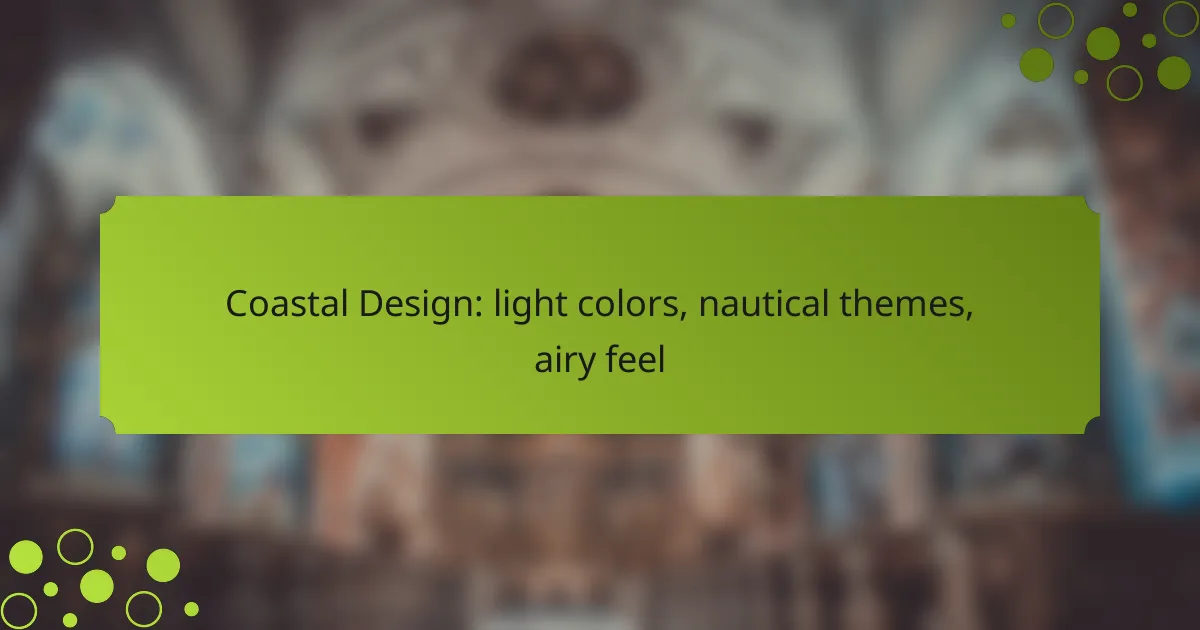Coastal design embodies a serene aesthetic characterized by light color palettes, nautical themes, and an airy ambiance. By utilizing soft hues like whites, blues, and grays, this style creates a refreshing atmosphere that mirrors the beauty of the coastline. Incorporating elements inspired by the sea enhances the tranquil feel, making it ideal for creating a relaxed coastal living space.

How to achieve a coastal design aesthetic in Australian homes?
To achieve a coastal design aesthetic in Australian homes, focus on light color palettes, nautical themes, and an airy feel. This style emphasizes a relaxed atmosphere that reflects the natural beauty of the Australian coastline.
Use light color palettes
Light color palettes are essential for creating a coastal design. Soft whites, pale blues, and sandy beiges evoke the colors of the beach and sky, making spaces feel more open and inviting. Consider using these shades on walls, furniture, and decor to enhance the airy feel.
When selecting colors, opt for matte or satin finishes to maintain a fresh, natural look. Avoid dark or overly saturated colors, as they can create a heavy atmosphere that contradicts the coastal aesthetic.
Incorporate nautical themes
Nautical themes can be seamlessly integrated into your coastal design through decor and accessories. Think about using items like ship wheels, anchors, and marine-inspired artwork to reinforce the seaside vibe. Fabrics with stripes or patterns reminiscent of sailing can also enhance the theme.
Be mindful not to overdo it; a few well-placed nautical elements can create a cohesive look without overwhelming the space. Balance these accents with neutral furnishings to maintain a light and airy atmosphere.
Focus on airy, open spaces
Creating airy, open spaces is crucial for a coastal design aesthetic. Aim for layouts that promote flow and connectivity between rooms. Use furniture that is lightweight and easy to move, allowing for flexibility in arrangement.
Consider minimizing clutter by choosing multifunctional pieces and keeping surfaces clear. This approach not only enhances the visual space but also contributes to a relaxed, beach-like environment.
Utilize natural materials
Natural materials play a significant role in achieving a coastal look. Incorporate elements like wood, wicker, and stone to bring the outdoors inside. Light-colored woods, such as pine or ash, can enhance the airy feel while adding warmth to the space.
When selecting materials, prioritize sustainability. Look for responsibly sourced options that reflect the natural beauty of the Australian landscape, such as reclaimed timber or bamboo.
Implement large windows for natural light
Large windows are vital for maximizing natural light in coastal design. They not only provide stunning views of the outdoors but also create a bright and welcoming atmosphere. Consider floor-to-ceiling windows or sliding glass doors that open to outdoor spaces.
When designing window placements, ensure they are oriented to capture the most sunlight throughout the day. This will enhance the overall brightness of your home and strengthen the connection to the coastal environment.

What are the best light colors for coastal design?
The best light colors for coastal design evoke a sense of tranquility and connection to the sea. Soft, airy hues like whites, blues, and grays create a refreshing atmosphere that enhances the nautical theme typical of coastal interiors.
Soft whites and creams
Soft whites and creams serve as a versatile backdrop in coastal design, reflecting natural light and making spaces feel larger and more open. These colors can range from pure white to warm cream tones, allowing for a variety of moods and styles.
When selecting whites and creams, consider the undertones. Warm whites pair well with natural wood accents, while cooler whites complement sleek, modern furnishings. Avoid stark whites that can feel harsh; instead, opt for softer shades that promote a serene environment.
Light blues and aquas
Light blues and aquas capture the essence of the ocean, bringing a refreshing and calming vibe to coastal spaces. These colors can vary from pale sky blues to deeper aqua tones, each evoking different aspects of coastal life.
Incorporating light blues can be done through wall paint, textiles, or decorative accents. Use these shades in combination with white or cream to maintain an airy feel. Be mindful of balance; too much blue can overwhelm a space, so consider using it as an accent rather than the primary color.
Pale grays and beiges
Pale grays and beiges provide a neutral foundation that complements other coastal colors beautifully. These shades can range from soft dove grays to sandy beiges, offering warmth without overshadowing the lightness of the design.
When choosing pale grays and beiges, look for those with subtle undertones that harmonize with your chosen palette. These colors work well for larger surfaces like walls or furniture, allowing for colorful accents in decor, such as cushions or artwork, to stand out. Aim for a balanced mix to create a cohesive and inviting coastal atmosphere.

Which nautical themes enhance coastal design?
Nautical themes that enhance coastal design typically include elements inspired by the sea, such as marine life, beach materials, and colors that evoke a sense of tranquility. Incorporating these themes creates an airy and refreshing atmosphere, perfect for coastal living.
Marine-inspired decor
Marine-inspired decor often features colors and materials that reflect the ocean, such as shades of blue, sandy beige, and crisp white. Consider using items like driftwood furniture, glass vases filled with seashells, or artwork depicting marine scenes to bring the essence of the coast indoors.
When selecting marine decor, focus on natural textures and organic shapes to enhance the coastal feel. Avoid overly ornate designs; instead, opt for simplicity and functionality that mirrors the beauty of the seaside.
Seashell and coral motifs
Seashell and coral motifs are classic elements in coastal design, adding a touch of nature’s artistry to your space. These motifs can be incorporated through decorative items like throw pillows, wall art, or even light fixtures that mimic coral shapes.
To effectively use seashell and coral designs, consider a balanced approach. Too many motifs can overwhelm a room, so aim for a few standout pieces that complement your overall color scheme and decor style.
Stripes and patterns reminiscent of the sea
Stripes and patterns reminiscent of the sea, such as nautical stripes or wave patterns, can add visual interest and depth to coastal spaces. These designs work well on textiles like curtains, rugs, or upholstery, creating a cohesive look that ties the room together.
When using stripes, consider the scale and direction; horizontal stripes can make a space feel wider, while vertical stripes can add height. Mixing patterns can be effective, but ensure they share a common color palette to maintain harmony in your coastal design.

What furniture styles complement coastal design?
Coastal design is best complemented by furniture styles that evoke a relaxed, beachy atmosphere. Key styles include shabby chic, weathered wood, and wicker or rattan accents, all of which enhance the airy feel and light color palette typical of coastal interiors.
Shabby chic furniture
Shabby chic furniture features a vintage aesthetic with a soft, worn look that aligns perfectly with coastal design. Pieces often come in light pastel colors or whitewashed finishes, creating a serene and inviting environment.
When selecting shabby chic items, look for distressed finishes and floral patterns to add character. Consider incorporating items like a weathered coffee table or a set of painted dining chairs to enhance the coastal vibe.
Weathered wood pieces
Weathered wood furniture brings a rustic charm that complements the coastal theme. The natural textures and muted tones of reclaimed wood can evoke the feeling of driftwood found on the beach.
Opt for items like reclaimed wood dining tables or sideboards that showcase their natural imperfections. These pieces not only add warmth but also serve as conversation starters, enhancing the overall aesthetic of your coastal space.
Wicker and rattan accents
Wicker and rattan accents are essential for achieving a light and airy coastal feel. These materials are lightweight and often used in furniture and decor, making them ideal for creating a relaxed atmosphere.
Incorporate wicker chairs, rattan light fixtures, or decorative baskets to add texture and warmth. Ensure that these pieces are in light colors or natural finishes to maintain the cohesive coastal look.

How to create an airy feel in coastal spaces?
To create an airy feel in coastal spaces, focus on maximizing natural light, selecting lightweight fabrics, and designing open floor plans. These elements work together to enhance the breezy, relaxed atmosphere typical of coastal design.
Maximize natural light
Natural light is essential for achieving an airy feel. Use large windows, skylights, and glass doors to invite sunlight into your space. Consider using sheer window treatments that allow light to filter in while maintaining privacy.
Position mirrors strategically to reflect light and create a sense of openness. Light-colored walls and ceilings can also help bounce light around the room, enhancing the overall brightness.
Choose lightweight fabrics
Selecting lightweight fabrics is crucial for maintaining a breezy atmosphere. Opt for materials like linen, cotton, and sheer textiles that allow air to circulate. These fabrics not only feel light but also add to the coastal aesthetic.
Incorporate light-colored upholstery and throw pillows to keep the space feeling fresh and inviting. Avoid heavy drapes and thick textiles that can weigh down the design and block natural light.
Incorporate open floor plans
An open floor plan promotes flow and connectivity, contributing to an airy feel. Design spaces that seamlessly transition from one area to another, such as combining the living room, dining area, and kitchen. This layout encourages movement and enhances the sense of space.
Use furniture arrangements that do not obstruct pathways and consider low-profile furniture to maintain sightlines. This approach not only makes the area feel larger but also fosters a relaxed, communal atmosphere typical of coastal living.
